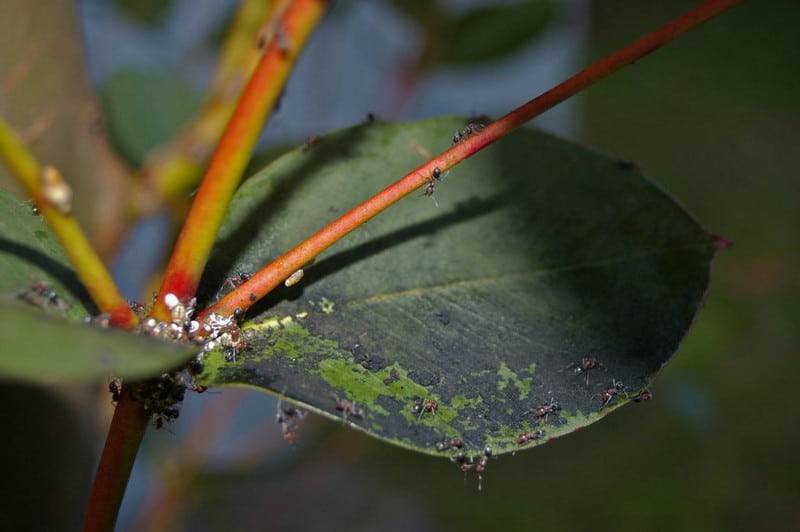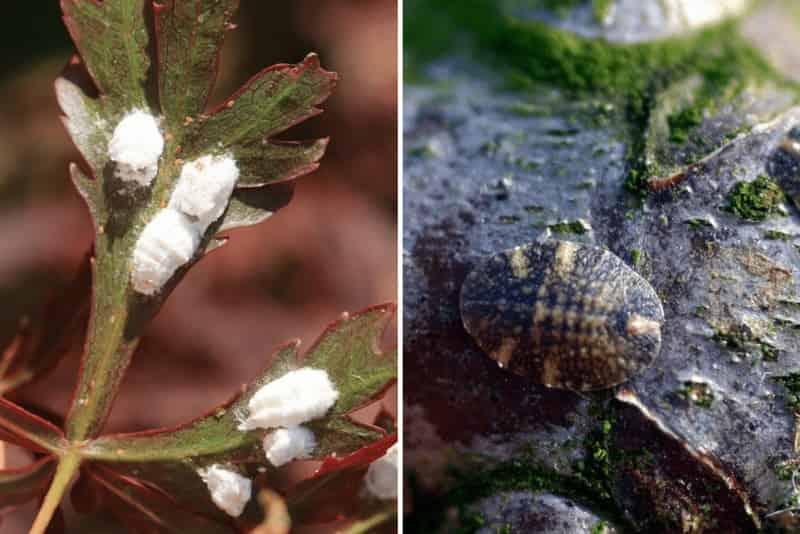
Mealybug: identification and treatment
Our tips for fighting naturally and effectively
Contents
The scale insect or rather scale insects, as they operate in groups, are small piercing-sucking insects (like aphids) that frequently parasitise the leaves, tender young shoots rich in sap, stems, and branches of many plants such as the lemon tree or orchids, indoors.
Scale insects belong to the Coccoidea family, and there are several types: mealybugs, armoured scale insects and shield scale insects, including the famous black scale of the olive tree. The latter are grouped under the term scale insects with shells.
Widely spread around the world, they thrive in confined, warm, and humid environments. They feed on sap, thereby weakening the plants. Some species secrete honeydew, making the plants sticky. They promote the appearance of a fungal disease: sooty mould. The leaves then become blackened with soot, which adversely affects photosynthesis and thus the growth of the plants.
Getting rid of scale insects can be quite complicated. However, there are treatments for scale insects that, when combined with favourable growing conditions and the preservation of biodiversity, will help limit the damage.
What are the symptoms of a scale insect attack?
Small and inconspicuous, scale insects are often difficult to spot.
However, a few clues give them away for those who know how to look: clusters of whitish secretion, small brownish spots, sticky droplets on the leaves. The foliage turns yellow prematurely or is covered with a black substance resembling soot. Young shoots are distorted. Growth and flowering are reduced.
 A black deposit of sooty mould almost completely covers a eucalyptus leaf. Meanwhile, ants feast on the honeydew secreted by the scale insects (Wikipedia)
A black deposit of sooty mould almost completely covers a eucalyptus leaf. Meanwhile, ants feast on the honeydew secreted by the scale insects (Wikipedia)
Be aware that an attack of scale insects rarely kills a plant. The damage is primarily aesthetic, and vegetable production can suffer. Regular monitoring allows you to guard against them and take action swiftly.
Mealybug
In our temperate regions, mealybugs are more of a problem in greenhouses and indoors.
Outdoors, it is in tropical and subtropical areas that they cause damage in vegetable gardens, orchards, and ornamental gardens. Mealybugs can be observed on date palms, citrus trees, succulents…
The most common species are: Planococcus citri, Pseudococcus viburni, and Pseudococcus longispinus.
Males resemble small wasps and are not harmful to plants; they are rarely seen. Females are white and oval-shaped. Waxy filaments of varying lengths can be observed depending on the species. The larvae are yellow.
Their life cycle depends on temperature: the warmer it is, the faster their development will be, and consequently, the greater the proliferation. Fertilised females lay several hundred eggs in a white cottony mass before dying. The larvae hatch and feed on the sap of the plants. They will go through 3 larval stages before becoming adults.

Planococcus citri (ephytia.inra.fr) – Pseudococcus viburni (ephytia.inra.fr) – Pseudococcus longispinus (bugguide.net)
The shield scale insect
Scale insects attack many fruit and ornamental trees such as apple, pear, olive, citrus trees, walnut, and oleander… but also on certain houseplants like succulents and cacti.
Most species do not produce honeydew, and the females are not attached to their shells, which vary in shape and colour from one species to another. There are no males among these scale insects.
Eggs are laid in autumn and spend the winter under the shell. The larvae appear in spring and migrate onto the branches before settling permanently. They become females that will lay eggs in turn.
We find Diaspis boiduvalii, Chrysomphalus aonidum, Lepidosaphes ulmi, and Saissetia oleae, the black scale of the olive tree.
They are also responsible for the crusting on branches and fruits. One can also observe cracking of the bark as well as drying out of the affected parts.

Diapsis boiduvalii (masdevallia68.blogspot.fr) – Chrysomphalus aonidum (entnemdept.ufl.edu) – Lepidosaphes ulmi (entomofaune.qc.ca) – Saissetia oleae (naturalist.fr)
The scale insect
Scale insects with shells thrive both indoors and outdoors. In the garden, one can see Pulvinaria regalis or Pulvinaria hydrangeae. These species produce a lot of honeydew. The bodies of the females are attached to a protective shell. It is the pulvinaria scale insects that are most often found on trees, forming large whitish cottony masses that protect both themselves and their eggs.
Fertilised females lay eggs in June before dying. The eggs hatch in July, and the mobile larvae colonise the surrounding plants. In autumn, the larvae migrate to the bark to hibernate. However, they continue to feed. After winter, the larvae metamorphose into adults, with the females returning to infest the plants, and a new cycle begins.
Scale insects with shells primarily develop on trees and bushes: hydrangea, magnolia, lime, dogwood, elm, maple …

Pulvinaria hydrangeae – Pulvinaria regalis (picssr.com)
Natural treatment against scale insects
How to get rid of scale insects?
Mealybugs are the easiest to eradicate, unlike scale insects which are very difficult to combat. You can significantly reduce their numbers, but be aware that there are no miracle solutions.
Rather than using an insecticidal product that will harm not only the scale insects but also the beneficial insects living nearby, we recommend natural solutions.
Preventive measures:
- Monitor closely and regularly so you can intervene quickly.
- Improve growing conditions (a struggling plant is more vulnerable) and know that good air circulation reduces the risk of attack.
- Take your plants outside as often as possible (outside of frost periods and not in direct sunlight), as scale insects dislike being in a more airy, cooler environment than indoors, and even less so in the rain. Furthermore, scale insects will be exposed to predators.
- Finally, always check the health status of plants before purchasing them.
In case of infestation, you have several solutions:
-
- Remember that scale insects are sensitive to the weather: take your plants outside.
- Remove mealybugs and cottony cushions with a cotton swab or a cloth soaked in 90° alcohol or soapy water. Rinse with clear water afterwards. Remove the waxy shells where the insects and eggs hide using a knife that does not cut deeply enough to damage the plant. Slide it between the shell and the plant. Collect the shells in a container as you go and then burn them. Use the soaked cloth to remove any remaining survivors.
- Try an anti-scale solution. For this, dilute in 1 litre of water:
– 1 teaspoon of liquid black soap
– 1 teaspoon of methylated spirits
– 1 teaspoon of vegetable oil, such as rapeseed oil.
Mix and spray twice at 30-minute intervals and then spray every 8 days until the scale insects disappear.
Diligence and repetition can help eliminate many scale insects or even get rid of them entirely. The oil suffocates the eggs, larvae, and adults. The black soap improves the spreading and adherence of the oil while having a caustic effect. Moreover, it is known for its insecticidal properties and acts by contact on the permeability of the insects’ cuticle. Finally, the alcohol disturbs them.
Place the plants in the shade or at least out of direct sunlight so that the treatment does not damage them.
In this recipe, alcohol is sometimes replaced by white vinegar, but it seems that its action is less effective.
Be aware that plants with delicate foliage such as ferns or fuzzy leaves do not tolerate this treatment. Similarly, do not spray on hydrangeas in full growth, as the treatment would burn the foliage. Intervene when the leaves have fallen or in spring before they appear.
You can also:
- Give a jet of water to the less fragile plants to dislodge the mobile scale insects present on the branches. You can also brush them off the trunks.
- During winter, cut off the branches (diameter less than 2 cm) infested with scale insects and burn them. This significantly reduces the population in the following spring.
- White oil (or paraffin oil) is effective against mealybugs. However, it has no effect on armored scale insects and shield scales, as nothing penetrates their shells!
- The black soap can be used on the larvae which have no protection. Repeat this treatment for several consecutive weeks to reduce the population of scale insects.
A balanced garden: the best prevention
The best prevention against scale insects is to encourage the presence of beneficials in your garden. Ladybirds, certain wasps, lacewings, bugs, hoverflies, not to mention great tits, are natural predators of scale insects. The sedentary life of females makes them very vulnerable to predators.
To help them:
- Take care to maintain wilder corners of the garden to provide space for host plants of many beneficials like nettle,
- Grow melliferous flowers such as phacelia,
- Feel free to install shelters, nesting boxes, insect hotels,
- Encourage biodiversity and avoid monoculture,
- Ban the use of any pesticidal products.
- Subscribe!
- Contents































Comments